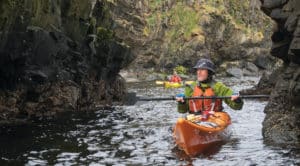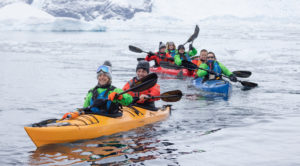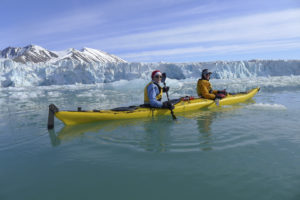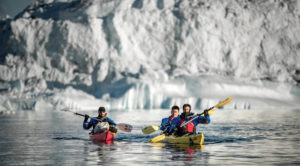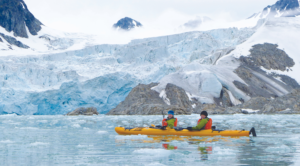Home > Expeditions > Traversing the Northwest Passage
Traversing the Northwest Passage
- 29 Days
- Departure/Arrival:
- Toronto, Canada - Anchorage, United States
- Voyage code:
- FNW003S
- Voyage type:
-
Polar Expedition
- Ship:
- Sylvia Earle
- Price:
-
USD $48,295.00
from USD $38,636.00/pp
Save 20%*Free Stateroom Upgrade for Balcony Stateroom Categories B & C*
Summary
Welcome to Aurora Expeditions’ Traversing the Northwest Passage (formerly called Complete Northwest Passage) expedition.
On this epic voyage inspired by Roald Amundsen’s historic expedition, we attempt to sail the full length of the Northwest Passage, carving our way west through the labyrinthine maze of waterways that hug the fabled islands of Arctic Canada until we reach the Beaufort Sea. Building on our classic Northwest Passage voyage, we visit historical sites explored by heroic explorers, meet the incredible folk that call this region home, and search for enigmatic wildlife found in this unique corner of the world. Pack ice may halt our voyage through the passage, so brace yourself for a genuine expedition where adventure awaits at every turn.
Highlights
• Stand in awe of Ilulissat Icefjord, a UNESCO World Heritage Site
• Hike on Devon Island, the world’s largest uninhabited island, which features stunning geology, fjords and glacial valleys to explore
• On Beechey Island, visit memorials and graves of explorers from John Franklin’s expedition
• Meet remarkable Inuit locals whose lives in this remote part of the world are anything but ordinary
Vaccines
Aurora Expeditions requires all embarking crew, Expedition Team and our passengers to be fully vaccinated against COVID-19 prior to embarking on any of its cruises.
It is important to note, that all travellers need to check and comply with the vaccine requirements of the country they are travelling to. Some countries have their own vaccination requirements. For example, Greenland; only accepts EMA approved vaccines which are: Pfizer, Johnson & Johnson, Moderna, AstraZeneca and Novavax.
As of 5th February 2022, Aurora will require all passengers to have also had a booster vaccination prior to boarding, if more than 5 months have passed after completing your primary COVID-19 vaccination (and at least 2 months after completing a J&J COVID-19 vaccination).
Officially certified proof of vaccination and booster will be required ahead of travel and we will require that it be emailed to Aurora no later than 15 days prior to departure.
Aurora Expeditions does not require passengers to undergo tests for COVID-19 prior to embarkation or during the voyage. We do not conduct routine COVID-19 testing unless required by the relevant authorities. However, passengers who report symptoms of COVID-19 to the medical team during a voyage will be tested.
Full vaccinations must occur four weeks prior to the embarkation date of the voyage and proof of vaccination will be required to be provided to Aurora Expeditions in advance of the voyage.
Acceptable vaccinations are limited to: Pfizer, Johnson & Johnson, Moderna, AstraZeneca, Novavax, Comirnaty, Spikevax, Vaxzevria, Jcovden, Nuvaxovid, COVID-19 Vaccine (inactivated, adjuvanted) Valneva, VidPrevtyn Beta, Sinovax and Sinopharm.
Gallery
In true expedition style we encourage exploration and adventure, offering flexibility in challenging environments in a way that puts you among the action to see and do as much as possible. This itinerary is only a guide and subject to change due to ice and weather conditions.
Itinerary
Day 1 Toronto
Having made your way to Toronto Airport, check-in at our group hotel located near the airport for an overnight stay. Please visit the Aurora Expeditions hospitality desk to collect your luggage cabin tags and to speak with our ground operations team, who may have information to share with you about pre-embarkation procedures and also about the charter flight to Nuuk tomorrow. You will receive Aurora Expeditions cabin tags for your luggage. Please clearly label the tags with your name and ship cabin number.
Accommodation: Westin Toronto Airport Hotel
Day 2 Nuuk
After breakfast at the hotel, board our charter flight to Nuuk, Greenland, where our vessel Sylvia Earle awaits. After boarding, there is time to settle into your cabin before our important safety briefings. This evening, meet your expedition team and crew at the Captain’s Welcome Drinks.
Day 3 Sisimiut
Greenland’s second largest town, Sisimiut is located approximately 54 kilometres (33.5 miles) north of the Arctic Circle, meaning that during summer, you can experience the midnight sun here. The town is famous for the old blue church with the gate made of whale bone. In the cosy museum next door to the church, you will find an excellent reconstruction of an Inuit turf house as well as exhibits of local history and early life in Greenland.
Sisimiut offers hiking trails with various degrees of difficulty. The easier trails take you through the town itself, its outskirts and into the mountains, where you will find spectacular vantage points.
Approximately 4,500 years ago, the Saqqaq culture arrived from Canada and settled in the area. They lived here for approximately 2,000 years, after which they mysteriously disappeared from the area. The Dorset culture arrived around 500 CE and stayed until the 1200s until they were replaced by the Thule culture, and today, most of the population of Sisimiut are descendants of the Thule culture.
Day 4 Ilulissat
In the afternoon we arrive in Ilulissat. Known as the ‘birthplace of icebergs’, this region produces some of the most dazzling icebergs found anywhere in the Arctic. Hike past the husky sledge dogs to the UNESCO World Heritage-listed Icefjord and stand in awe at its immensity. Sermeq Kujalleq, also known as Jakobshavn Glacier, is the most productive glacier – not only in Greenland but the entire Northern Hemisphere. It produces 20 million tonnes of ice each day, all floating into the Ilulissat Icefjord and Disko Bay.
Days 5-7 Northwest Greenland expedition cruising
Explore the northern stretches of West Greenland, home to traditional settlements and enormous icebergs that Greenland is famous for. Possibilities include Zodiac cruises, hikes and a visit to one of the small communities that are dotted along the coast. Kayakers can enjoy paddling among the icebergs and keeping watch for whales that frequent the area.
Day 8 At Sea
Our team of experts entertain us with informative talks about wildlife, geology and epic tales of early explorers such as Franklin and Amundsen.
Day 9 Pond Inlet (Mittimatalik), Nunavut, Canada
After clearance into Canada, we hope to visit Pond Inlet (Mittimatalik), a captivating Inuit community nestled on the northern tip of Baffin Island. Surrounded by towering ice-capped mountains, vast glaciers, and pristine fjords, this remote outpost offers an unparalleled wilderness experience. As you step ashore, you'll be greeted by the warm hospitality of the local Inuit, whose deep connection to the land is evident in their culture and lifestyle. Immerse yourself in their traditions through engaging cultural encounters and gain insights into their unique perspective on life in the Arctic.
Days 10-12 Devon Island (Tallurutit), Lancaster Sound
At a latitude of almost 75° degrees north, we are now truly in the High Arctic. Here, nutrient-rich waters support an abundance of wildlife, giving the area the moniker ‘wildlife superhighway’ of the Arctic. Devon Island (Tallurutit) is the largest uninhabited island on Earth and features stunning geology, with flat-topped mountains and glacial valleys giving Devon Island its unique character. We hope to visit Dundas Harbour to enjoy offers walks on undulating tundra, and perhaps some birdwatching. A dilapidated Royal Canadian Mounted Police outpost and remnants of a Hudson’s Bay Company trading post can be found here. In the bay, walruses are often present. Other possible places that we might visit include Croker Bay and Maxwell Bay.
At the western end of Devon Island lies Beechey Island (Iluvilik), where we plan to land. Named after Frederick William Beechey, the island is a designated Canadian National Historic Site. During the Franklin expedition of 1845–46, Franklin attempted to sail through the Northwest Passage with HMS Erebus and HMS Terror, with perilous results – three of his men are buried here. Roald Amundsen landed at Beechey Island in 1903, during the first successful voyage by ship to fully transit the Northwest Passage from the Atlantic Ocean to the Pacific Ocean.
Just a short distance away, Radstock Bay offers a captivating contrast to the open sea. Here, we’ll disembark via Zodiac onto a beach strewn with remnants of the past. Explore the ruins of a Thule village nestled beneath the imposing Caswell Tower, where well preserved stone dwellings coexist with artifacts from later explorers. Witness the stark beauty of this remote bay, characterised by its dramatic cliffs, gravelly beaches, and the scattered remains of whale skeletons that have shaped the landscape and the lives of those who called it home.
Days 13–17 Expedition Cruising
In genuine expeditionary style, our itinerary for the following days is heavily dependent on weather conditions and unpredictable sea ice. The following places are some that we hope to visit.
Prince Leopold Island (Appait)
On the southern side of Lancaster Sound from Beechey Island lie the towering bird cliffs of Prince Leopold Island (Appait), a historic site where in 1848, English explorer James Clark Ross overwintered during the search for the missing Franklin expedition. Prince Leopold Island is the most important bird sanctuary in the Canadian Arctic, with approximately 500,000 birds nesting here in summer. Ringed seals are often spotted on the sea ice around the island and polar bears often lurk nearby.
Port Leopold
Port Leopold, a barren, windswept bay on the northeastern corner of Somerset Island (Inuktitut Kuuganajuk), is steeped in history. Here, the crews of HMS Enterprise and Investigator were forced to endure a harsh winter while searching for the lost Franklin expedition. Their presence is indelibly marked on a rock engraved with "1849" and the ships' initials. The desolate landscape is punctuated by a lone Hudson Bay Company hut, a failed trading post from the 1920s. Hikers will have the opportunity to explore the coastline, discovering the historic Hudson Bay Company house and intriguing Inuit archaeological sites. Be amazed by the otherworldly formations shaped by the region’s freezing and thawing cycles, which our expedition team will detail during recap. Nearby, a cairn marks the spot where Ross's rescue expedition left vital supplies.
Hazard Inlet (Qariaraajuk)
We hope to visit an Inuit site inhabited by bowhead whale hunters during the 15th and 16th centuries. The remains of over 100 bowheads are scattered across the village and beach, a testament to the community's reliance on this marine giant. Excavations have uncovered around 20 sod houses, though evidence suggests there may have been as many as 40. The cliff face behind the site holds community burial grounds, while caches, kayak, and umiak stands line the shore. This remarkable site offers a poignant glimpse into the lives of these Inuit families, who worked cooperatively to hunt bowhead whales for sustenance and building materials. It's an extraordinary privilege to experience this piece of history firsthand.
Point Zenith
Point Zenith, a rocky promontory jutting into the ocean, offers breathtaking panoramic views. As you step ashore, you'll feel a profound sense of isolation and wonder. This is a place where time seems to stand still, and the only sounds are the wind and the crunch beneath your boots.
King William Island (Qikiqtaq)
Remains attributed to the Franklin expedition have been found at 35 different locations on King William Island (Qikiqtaq) and on nearby Adelaide Peninsula. South of Cape Felix, in Victoria Strait, we hope to Zodiac close to where the wrecks of HMS Erebus and HMS Terror were eventually found in 2014 and 2016, respectively.
Cambridge Bay (Iqaluktuuttiaq)
The administrative and transportation hub of the region, Cambridge Bay (Iqaluktuuttiaq) is the largest stop for passenger and research vessels traversing the Northwest Passage and unofficially marks the midpoint for voyages of the Northwest Passage. Zodiac ashore for an exploration of this Inuit settlement located in the high arctic. Enjoy a walk through the village, where you can visit the local church, visitor centre and support the local community by purchasing some locally made handicrafts.
Days 18-22 Coronation and Amundsen Gulfs
Your experienced expedition team will create your day-by-day itineraries based on sea ice and weather conditions. Apart from Franklin, other heroic explorers including Amundsen explored this territory, and we may visit the same places as early explorers. We hope to meet the resilient locals who make the extreme far north their home.
Below are some of the places in the area that we may visit:
Johansen Bay, Edinburgh Island (Egloovikan)
We hope to enjoy a Zodiac excursion within an estuary of at the northeast end of Johansen Bay and up the river towards the lake. Wildlife including caribous, reindeer, arctic foxes, hares and peregrine falcons frequent the area.
Nearby, Edinburgh Island (Egloovikan) is a small and uninhabited island in Canada’s Nunavut region. The scenery consists of colourful flowering shrubs, beaches tinged in stunning ochres, while the surrounding cliffs shaded in rich, deep tones. A possible walk to a lookout overlooking the lake offers spectacular views over lakes, sea and mountains.
Port Epworth (Kugluktoalok)
The Tree River area on the mainland — also known a Port Epworth — provides a spectacular backdrop our possible exploration, with its river and shallow lakes, striking sedimentary rock outcrops, and bright autumnal colours of tundra. This area is also known for its stromatolites – the petrified remains of ancient mounds of algae, formed some two billion years ago by the same microorganisms responsible for producing the oxygen we breathe today.
Smoking Hills (Ingniryuat), Franklin Bay
The Smoking Hills (Ingniryuat) in Canada’s Northwest Territories have been smouldering, sending plumes of gas across the landscape, for centuries. Technically sea cliffs, you would be forgiven for thinking that the multicoloured fiery natural phenomenon is the set to an apocalyptic movie depicting the end of the world. The smoke is caused by layers of combustible, sulphur-rich lignite (brown coal) that ignites and emit sulphurous gas into the air, when exposed to erosion and landslides, which also creates a dazzling colouration of the rocks.
Days 23-25 Beaufort Sea
Excitement builds as we sail the Beaufort Sea. Whether you are out on deck or in the comfort of one of the observation lounges, watch as the captain navigates our state-of-the-art vessel through these waterways, which are frozen for most of the year. Keep a close watch for wildlife including Beluga whales and polar bears that are often seen here.
Cruising further west, we hope to Zodiac cruise (subject to permitting) to Herschel Island. This historic island, inhabited by the Thule people for over a millennium, was first charted by Sir John Franklin in 1825. It later transformed into a bustling whaling station during the late 19th century, supporting a winter community of hundreds and a fleet of ships. However, the industry's decline in the early 20th century led to the island's gradual abandonment. Today, protected as a territorial park, Herschel Island offers a unique glimpse into the region's rich history and stunning Arctic wilderness.
At Prudhoe Bay, we farewell Canada and enter the United States.
Days 26-27 Chukchi Sea and Bering Strait
As we sail westwards to Nome, along the northern coast of Alaska to where the U.S and Russia are only 100 km (60 miles) apart, separated by the Bering Sea, there is ample time to reflect on our adventures while scanning the water for marine life. Share, edit and submit pictures in our photo competition and attend final lectures from our team of onboard experts. We hope to get permission to ship cruise close by Point Hope, Little Diomede and King islands in Alaska.
Day 28 Disembark in Nome, fly to Anchorage
During the early morning, we cruise into Nome and disembark at approximately 8.00 am. Farewell your Expedition Team before transfer to the airport for a charter flight to Anchorage for an overnight stay.
Accommodation: Captain Cook Hotel Anchorage
Day 29 Depart Anchorage
Transfer to the airport for your onward journey.
Inclusions
- Airport arrival and departure transfers to/from our group hotel on the first day and the final day of your voyage package.
- One night’s hotel accommodation including breakfast, in Toronto on Day 1.
- Charter flight from Toronto to Nuuk on Day 2.
- Charter flight from Nome to Anchorage on Day 28.
- One night’s hotel accommodation including breakfast, in Anchorage on Day 28.
- Onboard accommodation during voyage, including daily cabin service.
- All meals, snacks, tea, coffee, soft drinks and juices during voyage.
- Beer and house wine with dinner.
- Captain’s Farewell reception including four-course dinner, house cocktails, house beer and wine, non-alcoholic beverages.
- All shore excursions and Zodiac cruises.
- Educational lectures and guiding services provided by our expedition team.
- Complimentary access to onboard expedition doctor and medical clinic (initial consultation).
- One 3-in-1 waterproof, polar expedition jacket.
- Complimentary use of Muck Boots during the voyage.
- Comprehensive pre-departure information.
- Port surcharges, permits and landing fees.
- Wi-Fi. Please note we travel to remote regions and therefore the connection can be unreliable.
Exclusions
- International or domestic flights – unless specified in the itinerary.
- Transfers – unless specified in the itinerary.
- Airport arrival or departure taxes.
- Passport, visa, reciprocity and vaccination fees and charges.
- Travel insurance or emergency evacuation charges.
- Hotel accommodation and meals – unless specified in the itinerary.
- Optional excursions and optional activity surcharges.
- All items of a personal nature, including but not limited to alcoholic beverages outside of dinner service, gratuities, laundry services, personal clothing, medical expenses or phone charges.
Note: A $15 USD per person per day gratuity for the crew is automatically added to your onboard account. It is at your discretion if you would like to remove the tip (or adjust the amount) when you settle your bill. It is not necessary to tip the expedition team members. This gratuity amount is included for suites as part of their ‘Suite Benefits’.
Included Activities
Bird watching
Lectures on wildlife, our environment, history and destinations
Near shore cruises
Photography
Polar plunge
Trips ashore
Walking
Whale and mammal spotting
Zodiac cruises
Add-on Activities
Sea Kayaking
From USD $1,660.00/pp
Sea Kayaking Vacations One of the most exhilarating ways to experience Antarctica, the Arctic and beyond. Sea kayaking holidays in …
Sea Kayaking
Sea Kayaking Vacations
One of the most exhilarating ways to experience Antarctica, the Arctic and beyond.
Sea kayaking holidays in the humbling wilderness of Antarctica, the Arctic, and some of the world’s most biodiverse regions, are guaranteed to stir your soul. Paddle around brash ice and near icebergs of all shapes and sizes, absorbing the majestic scenery as it unfolds before you.
This Kayaking Program was created by kayakers for kayakers! Our program style offers the chance to develop and enhance your skills and to connect with our expert guides and your fellow Expeditioners. Participating with the small group through your voyage will minimise wasted time with briefings and equipment tryouts and maximise time on the water.
All of our Expert Guides are professional kayak guides, who have led trips around the world, specialise in the Polar Regions and have been chosen for their passion for the sport.
Kayaking is one of the best ways to access and intimately explore the beautiful coastlines we visit and make the most of your time in the wild and remote destinations we visit.
You have the option to discuss with the guides what you want out of your trip and they will help with recommendations on when to paddle, when to go ashore and when it’s possible to do both in one outing.
Our purpose-built ships have been designed with the activities in mind, each equipped with dedicated space for our high-end equipment, including Kokatat dry suits, Seals sprayskirts, PFD’s from Astral and paddles from Werner and Aqua Bound.
Please note:
- Kayakers must be 14 years or over. A Parent or Guardian’s signature is required for participants between 14 and 18 years old.
- There is upper size limit in the drysuits we provide onboard. If you cannot find a suitable size within our range and you would like to bring your own, please contact our Activity Specialist to discuss in more detail.
- Travel Insurance is mandatory on all Aurora Expeditions voyages. An additional policy or premium may be required to ensure you have adequate coverage for including this activity.
Sea kayaking holidays in the humbling wilderness of Antarctica, the Arctic, and some of the world’s most biodiverse regions, are guaranteed to stir your soul. Paddle around brash ice and near icebergs of all shapes and sizes, absorbing the majestic scenery as it unfolds before you.
This Kayaking Program was created by kayakers for kayakers! Our program style offers the chance to develop and enhance your skills and to connect with our expert guides and your fellow Expeditioners. Participating with the small group through your voyage will minimise wasted time with briefings and equipment tryouts and maximise time on the water.
Kayaking is one of the best ways to access and intimately explore the beautiful coastlines we visit and make the most of your time in the wild and remote destinations we visit. You have the option to discuss with the guides what you want out of your trip and they will help with recommendations on when to paddle, when to go ashore and when it’s possible to do both in one outing.
Our purpose-built ships have been designed with the activities in mind, each equipr with dedicated space for our high-end equipment, including Kokatat dry suits, Seals sprayskirts, PFD’s from Astral and paddles from Werner and Aqua Bound.
‘Getting out amongst it’ is our philosophy, and that is exactly what we do. Weather permitting, the sea kayaking activity is normally available anytime the other expeditioners go out. Rather than travelling large distances, our aim is to ensure you see as much as possible. We paddle between 5 to 15 kilometres (2 to 4 hours) per outing, often offering a combination of both kayaking and onshore landings so you won’t miss out.
Each small group of kayakers (up to 10 per guide) will have their own intimate exploration of the small hidden bays and coasts that are inaccessible to Zodiacs. Of course, we also make time for your own shore excursions and wildlife encounters.
The elements play an important role in our sea kayaking program. It is important that you have an adventurous attitude and understand that the weather can impact our kayaking time.
The level of experience required differs slightly depending on the region you are visiting. For all trips, a basic level of sea kayak experience is required, equivalent to that gained in a half day Paddle Australia “Intro Sea Skills” course. You do not need to be an expert or know how to roll; however, it is encouraged that you are comfortable in a sea kayak in the ocean, and are required to be able to swim, have a moderate level of physical fitness, and no medical conditions that prevent you from safely participating. We are happy to assist you with any preparation you may need or want prior to your voyage.
Our guides do not offer instructional classes for beginners. Therefore, the sea kayaking option is unsuitable for complete novices. If your experience is limited, we encourage you to contact us to discuss your suitability. There is often ample time to gain the required experience before you depart.
Your guide will assess your ability on the initial paddle, and if you have insufficient experience, he or she reserves the right to restrict your participation in rougher conditions.
You should be fit enough to paddle for 15 minutes without stopping at a moderate pace, for up to three hours at a time with breaks. We encourage a moderate level of fitness and recent kayaking experience as much as possible.
Polar regions
During summer the air temperature in the Antarctic Peninsula, Greenland and Spitsbergen are generally above freezing but can range from -4°C to +5°C / 24.8°F to 41°F. The water temperature in the polar regions is close to freezing and winds sweep off the glaciers, making paddling a chilling experience. Scotland, Iceland, Norwegian coasts are warmer with water temperatures of around 12°C / 53.6°F. In the Antarctic Peninsula, and Svalbard we often paddle in sheltered locations with generally calm conditions. In exposed locations places like South Georgia, we often encounter stronger wind and more challenging paddling conditions. Your guides will be constantly searching for a way to get you out safely and enjoyably.
Temperate regions
The northern waters in Scotland, Faroes, Iceland and Norway are warmer than the polar regions but water temperatures of around 12 °C/ 53.6°F mean you may opt to wear your paddle jacket on a warm, sunny day or our dry suits on a cool day. Surf landings are not likely, but you must be capable of paddling in a small swell or wind chop, with winds up to 20 knots. With that being said, we will not paddle if wind conditions are too strong and there is no sheltered area for paddling.
Tropical regions
In Costa Rica and Panama, April is the end of the dry season. The shoulder season begins in May, bringing increased humidity. Afternoon rain showers are possible in May with temperatures ranging from 26-36 °C (80- 96 °F). Winds are generally light at this time of year. The water temperature ranges from 27 -29 °C. Surf landings are not likely, but be prepared to paddle in a small swell or wind chop, with winds up to 15 knots. Again, we will not paddle if wind conditions are too strong and there is no sheltered area for paddling.
The Sea Kayaking activity is available for an additional surcharge and includes guided excursions and kayaking equipment. Fares for this activity start from US$900, AU$1,250, £460 or €550.
Prices are indicative only and are variable. They are calculated based on the days of voyage, ability to carry out the activity and exchange rates.
Aurora Expeditions will be providing kayak booties and dry suits. Below is the measurement chart for the sizes we provide. If you prefer to bring your own dry suit for this activity, please contact our Activity Specialist to discuss the suitability of your equipment.
If you cannot find a suitable size from the options available and you do not have your own custom dry suit, unfortunately we will be unable to accommodate you for this activity.

Top reasons to choose Sea Kayaking
See wildlife unobtrusively
Kayaking is one of the best ways to spot rare wildlife, from penguins to puffins.
Better access
Access intimate bays and coves that bigger crafts can't reach.
Knowledgeable guides
Our experienced sea kayak guides will help bring your chosen destination to life.
Become an expert
Hone your kayaking skills and gain a hobby for life!
Make friends
Become lifelong friends with your small group of like-minded adventurers.
Stay fit on your holiday
Being active every day on your holiday means you don't have to feel guilty about being spoilt by our expert chefs!
Enhance your experience
Add another layer to your once-in-a-lifetime holiday and make the most out of your time in some of the most remote places on earth.
It's fun!
Have the time of your life exploring some of the wildest places on earth from the water.
Sea Kayaking FAQs
There are 20 paces available and our guide to paddler ratio is 1:10 and we provide an accompanying safety Zodiac.
Kayakers must be 14 or over. Parent or Guardian’s signature is required for participants between 14 and 18 years old.
Sea kayaking is offered in place of regular shore excursions. We aim to paddle as often as possible. Depending on the voyage, we generally aim to paddle twice per day.
We will give you a drybag for extra clothing, binoculars and anything that needs to be kept dry. You should also carry a water bottle. We recommend bringing a waterproof camera or phone, or ensuring you have a good quality waterproof case.
If the weather changes during our outing we will head back to the ship and perhaps join a shore excursion. The ship’s captain, expedition leader and kayak guide always maintain close contact to ensure a safe paddling experience. We do not attempt to paddle too far away from the ship. The emphasis is on experiencing the destination rather than travelling long distances.
The kayaks are made with a hard plastic and are easily paddled in swell and conducting shore landings, and through small patches of brash ice. We manoeuvre around the larger ice chunks and floes.
Polar regions
Kayaking in the poles offers a unique wildlife viewing experience. In Antarctica, we have many opportunities to encounter penguins, seals and whales, and occasionally we may even spot leopard seals or orcas. In the Arctic, we’ll paddle under nesting bird colonies, past massive glaciers and around large icebergs, however we maintain a safe distance from polar bears and walruses. Our guides carry rifles and flare guns in the Arctic to ensure your safety against polar bears.
Temperate regions
Kayakers in wild temperate regions will have a unique wildlife experience, with possible encounters with seals and basking sharks. You will have the opportunity to view some of the largest sea bird colonies in the northern hemisphere.
Tropical regions
The superb wildlife-viewing opportunities are endless in the astonishingly biodiverse nature reserves we visit. Kayaks offer a unique opportunity to view marine and land mammals, coral reefs, tropical fish, sea birds and an astonishing range of rainforest birds. We will bring our snorkelling gear with us during our paddles and take advantage of any opportunities to view marine life up close.
In the unlikely event of a capsize, your experienced guide will assist by righting the kayak, stabilising it then pumping it out. Paddlers will re-enter with the guide’s help, or with a support Zodiac. With drysuits and warm clothing underneath you will be comfortable in cold water for up to half an hour. Note that the kayaks have separate compartments with bulkheads, which means they will float after a capsize.
No. Each kayaking place is for one person only. We value a program style that maintains participants through trip to maximise skill progression, group bonding and dynamics, and minimise wasted time with briefings and equipment tryouts.
Contact Us
Sorry, an error occurred.
Staterooms & Prices
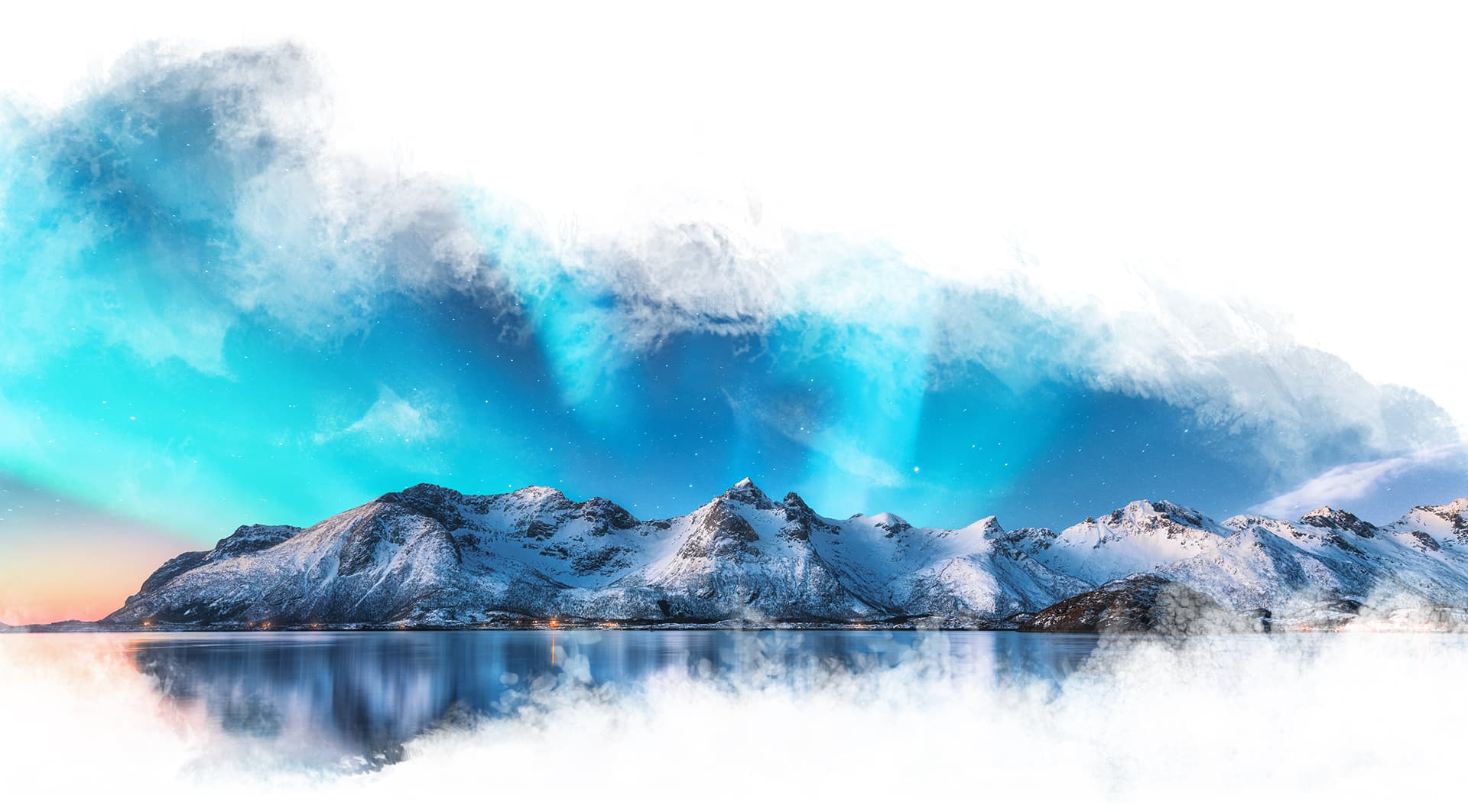
Request a customised booking
Want to book flights and accommodation with us or simply want some additional information? Click the button below and fill out the form, our expedition experts are more than happy to help.
*Terms & Conditions apply. Valid on select ship voyages only. Offer is valid on new bookings only aboard the Greg Mortimer, Sylvia Earle or Douglas Mawson which must be booked and deposited by December 31, 2024. Promotion is subject to availability at the time of booking and capacity controlled. The promotion is only available in conjunction with the back to back voyage discount or the loyalty program offer, and not available with any other offer. The promotion can be withdrawn at any time and is not redeemable for cash. Normal booking terms and conditions apply. To confirm your booking, a completed booking form and non-refundable deposit of $2,500 pp in the booking currency is required within 7 days of reserved berth/s. Additional terms and conditions may apply. Please see full terms and conditions.
^Terms & Conditions apply. Additional 5% discount valid on both voyages but two voyages must connect back to back in terms of dates to be eligible. Offer is valid on new bookings only aboard the Greg Mortimer or Sylvia Earle. Promotions are subject to availability at the time of booking and capacity controlled. The promotion is only available in conjunction with early bird voyage discount or the loyalty program offer, and not available with any other offer. The offer can be withdrawn at any time and are not redeemable for cash. Normal booking terms and conditions apply. Please see full terms and conditions.


